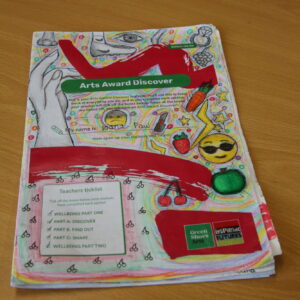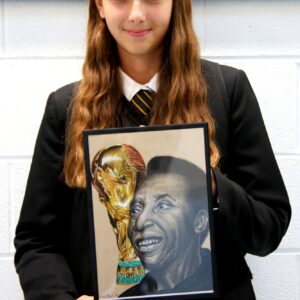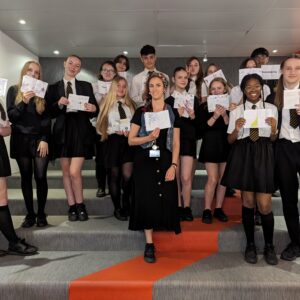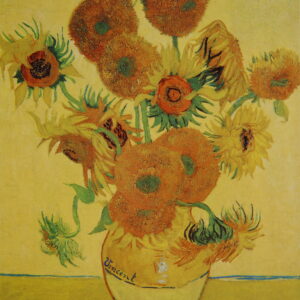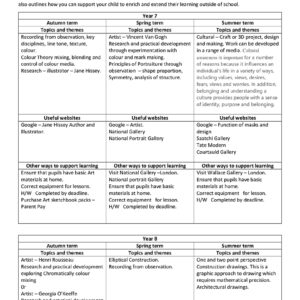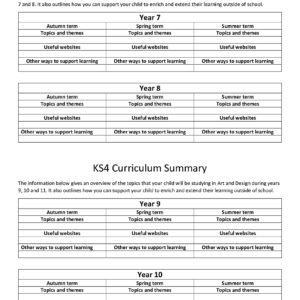Welcome to the Visual Arts Department at Eastbrook School!
A successful student of the visual arts at Eastbrook School develops knowledge, understanding and skills through integrated practical, academic, critical and contextual study. They gain a broad range of practical experience in the visual arts and demonstrate critical appreciation of sources that inform their creative intentions. These intentions are realised through purposeful engagement with visual language, visual concepts, media, materials and the application of appropriate techniques and working methods. Students develop and apply relevant subject-specific skills to visually communicate personal ideas, meanings and responses. Students, over time, reflect critically upon their creative journey and its effectiveness in relation to their personal body of work.
The visual arts embody some of the highest forms of human creativity and we aim to engage, inspire and challenge students not only to become creative learners but to become principled, resilient, open, understanding and disciplined individuals. We aim to equip them with the knowledge skills and understanding to experiment, invent and create their own thoughtful work in response to a theme. As students progress through the key stages, they are able to respond critically and develop a more rigorous understanding of the visual arts in a wider context. They gain an insight into how art both reflects and shapes our history, and contributes to its culture, creativity and wealth. We believe that studying the visual arts provides students with technical skills and a cultural literacy, which increases employability and social mobility.
Studying the visual arts can also help with understanding, interpreting and negotiating the complexities and diversity of society. We give the next generation of artists, designers, engineers, creators and cultural leaders the opportunity to develop the imagination and skills that are vital to our future. Arts and cultural learning encourages awareness, empathy and appreciation of differences and diversity and the views of others.
The visual arts curriculum successfully develops students’ character strengths and virtues through the PROUD ethos. Students learn to be principled and open when working independently with expensive equipment, and by supporting each other when learning new skills and complex techniques. Students gain a deep level of understanding of the visual arts and relevant scientific principles, through curiosity and critical thinking skills. They must be disciplined when building a portfolio of work which successfully meets the AQA examining body assessment objectives, through sustained and consistent practical application of skills to realise personal intentions. They take responsibility for the equipment and studio space with respect and honesty. Students are challenged at every stage to work through problems and to overcome misconceptions about the subject, gaining resilience.
The underlining ethos of the visual arts curriculum is to inspire within each student a passion for art as a visual language, enabling them to successfully work as independent artistic practitioners. Furthermore, students are encouraged to contribute to the life of the school and community by, for example, volunteering their skills in documenting whole school activities, participating in borough arts events and providing high quality photographic images for display around the school.
The curriculum also prepares students for life beyond secondary education by instilling a cultural literacy through enriched experiences that they may not otherwise enjoy and learn from. These take the form of encounters with industry professionals, curated gallery visits and location shoots, creative workshops and university art course taster days, enabling students to access careers in the creative industries and beyond. Students gain a sense of place within the world and build a cultural hinterland which endures for a lifetime.
Our Curriculum
The curriculum is spiral in nature and designed holistically, so that students are regularly engaged with all visual art skills and techniques, revisiting them regularly to make significant progress whilst allowing for stretch and challenge, as well as meaningful the opportunity to address common misconceptions and setbacks.
Key Stage 3 scheme of works are designed to reinforce and embed Key Stage 2 knowledge and introduce students to a wide range of artistic skills and understanding of new concepts to prepare them in readiness for KS4 and beyond. Practical skills in drawing, work in colour and print are crucial to their artistic development.
Students are provided with the opportunity to develop their understanding of foundational drawing skills of line, tone, texture, pattern, shape and proportion. These skills are revisited within the homework tasks where students have the opportunity to practise and reinforce their learning. They experiment with colour media, reinforcing and extending their knowledge of colour theory, and progress into the manipulation of materials through print and collage work. Students are then given the opportunity to develop their projects independently and creatively, having developed their understanding from a common starting point. This is an important element to success at KS4. Year 9 and all highly developed students will be encouraged to extend their work into photography, creating bespoke primary sources for further artistic development.
Assessment of work is a blend of whole class, peer led and direct feedback. Each student is encouraged to recognise their strengths and areas for progression and to discuss their personal responses to the work. GCSE assessment objectives are used by the teacher as a vehicle with which to steer the students towards an understanding of how they successfully develop projects to a highly developed standard.
Key Stage 3 Waypoints
Year 7
Development of foundational drawing skills of observation, line, tone, texture, pattern, shape and proportion.Development of manipulation skills through drawing in a range of media.
Development and application of colour theory, with a degree of control.
Development of abstract thinking and creativity through simplification, abstraction, design and colour manipulation skills.
Development of basic research skills such as understanding time and place, culture, inspiration, style and technique. Development of emerging skills in written and oral presentation.
Development of cultural understanding through a portraiture and identity project.
Year 8
Building on prior knowledge of the above.
Developing architectural, graphic, construction and design skills, through precision drawing in one and two-point perspective, drawing elliptical forms and SD modelling.
Year 9
Building on prior knowledge of the above.
Developing an understanding and skill set in photography, through the use of cameras, the studio and photo editing software.
When students have achieved or exceeded these expectations they are considered ‘Key Stage 4 Ready’.
Key Stage 4 Waypoints
Each student is provided with the GCSE Art & Design or Photography course outline and timeline, curriculum summary and subject booklet, with information as to how the course is assessed both formatively and summatively. It also includes signposting to useful sources of knowledge and expertise, such as galleries, websites, exemplar work and methods of compiling a portfolio of work. This enables the student to take ownership of their progress on the course, working in greater depth for the more able students for example, and to independently address areas for further development. Parents/ carers are encouraged to engage with the curriculum and take their children to galleries and places of interest, as well as regularly review their child’s work.
As students’ progress onto the GCSE Art & Design and Photography courses, they develop a more rigorous understanding of the visual arts. They learn how art as a visual language both reflects and shapes our history contributing to the culture, creativity and wealth of our nation. In the GCSE Photography course, Year 10 begins with an initial, developmental stage of learning which progresses on from their Year 9 introduction and enables students to gain a more solid foundation of the subject.
Students move forward with their learning within the curriculum ethos of ‘student as independent artistic practitioner’. They work towards producing a highly individual, personal portfolio of work (Component 1 of their submission) via the setting of practical projects, through which they must evidence their responses against the examining body assessment objectives. These objectives are referred to throughout the curriculum, enabling students to understand how to respond to them in their everyday practise.
Students are aided in building their portfolio with one-to-one mentoring, peer and group work, curated excursions such as gallery visits and location shoots, as well as technical support. The curriculum develops students’ empathy for local, environmental and global issues. For example, the portraiture project may tackle issues such as identity, social media, and mental and physical well-being. A landscape project enables students to respond to the urban landscape, the local architecture, how the structures and spaces around them are used, and even issues such as local gentrification or environmental concerns.
Students are ready to tackle the examining body externally set assignment (Component 2 of their submission) once they have a thorough comprehension of portfolio building via completion of Component 1. Students understand the need to respond personally to the assignment and are able to proceed through the component with autonomy. The GCSE curriculum, therefore, is designed to generate independent, disciplined, highly creative and motivated young adults, ready for their next stage of learning and the world of work.
Year 10
Development of portfolio building, in response to a range of starting points.
Development of how to meet the four examining body assessment objectives, to a highly developed standard and beyond.
Research and investigation skills developed from a common starting point; written and visual.
Personal skill development through experimentation and techniques with range of media.
Recording and refining work through drawings, sketches, visual resources and annotations.
Final outcomes based on previous preparation.
Year 11
The submission of a portfolio of evidence, meeting the assessment objectives.
An understanding of how to independently build a unit of work, responding to an externally set starting point, which meets the assessment objectives to a highly developed standard and beyond.
The KS3 curriculum accounts for and builds on the key elements that students have studied during KS2. These are summarised below:
The National Curriculum for Art and Design aims to ensure that all students:
Produce creative work, exploring their ideas and recording their experiences.
Become more proficient in drawing, painting, sculpture and other art, craft and design techniques.
Evaluate and analyse creative works using the language of art, craft and design.
Know about artists, craft makers and designers, and understand the historic and cultural development of their art forms.
KS3 Sequencing
By the end of KS3 students are expected to know, apply and understand the methods, skills and processes specified in their programme of study, which is laid out by the supported framework of the National Curriculum.
Students are taught to develop their creativity and ideas, and increase proficiency in their practical execution. They are taught to develop a critical understanding of the works of artists, architects and designers, and have an increased confidence in their own ability to express reasoned judgements that can inform their own work.
Students are taught to use a range of techniques to record their observations using a broad range of media as a basis for exploring their ideas. Students gain an increased proficiency in the handling and manipulation of different materials.
Students learn how to critically and technically analyse and evaluate their own work and others, identifying key features, making comparisons and use the information to inform their own actions to improve work.
There is emphasis on drawing skills and techniques using a broad range of media to communicate observations developing understanding of the control of line, shape, tone, colour, pattern, texture, form and space.
Painting increases control of wet colour media. Students gain an insight into the theory of colour mixing developing awareness on the development of colour mixing through Primary and Secondary colours, shades and tones, hues and tints. Students learn how to control the application of media and have the opportunity to experiment with techniques such as washes, transparencies, opaque layering and combined materials to create textural surfaces.
Students are also given the opportunity to develop skills through 3D modelling which develops their dexterity and ability to problem solve through the manipulation of different materials or through the printmaking and pattern making process which develops their technical ability to create an impression or print from a textured surface.
Students increase their confidence through being taught different ways in which they can design and develop a range of creative outcomes and personal ideas.
They learn how to make individual choices, improve their creative and technical skills and gain mastery of specific techniques and develop an increased confidence in their ability to refine their ideas as work progresses.
Students are able to evaluate their own work and that of leading artists making informed personal judgements and gain a clearer understanding of time and place having an informed insight of the context in which the works were produced.
Links are made with mathematics (numeracy) through ability to apply number. Students manage concepts of scale, proportion, angles and more specific geometrical terms when focus is on construction and perspective studies.
Links with science are developed through the students’ understanding of the development of colour theory and light.
Students are introduced to the history of art and are taught about periods, styles and movements from ancient times up to the present day. Links with history and geography through contextual studies is vital to students understanding of historical, political, spiritual, cultural, social, moral and environmental context in which work is created.
The KS3 curriculum focuses on the artistic skills, techniques and understanding required to make a confident transition into KS4 i.e. to be Key Stage 4 ready.
KS4 Sequencing
At KS4, students select either the AQA GCSE Art, Craft and Design or Photography endorsements. The curriculum is designed to promote learning across a variety of experiences to generate different kind of working and outcomes. The emphasis is on increased flexibility and breadth of approach through a choice of specialisms. The work is not limited to one area of study and therefore students are able to work to their strengths and build on the skills introduced and developed in KS3.
Teachers are free to develop bespoke units of work, which provide variety and suitability for the cohort, meeting their specific needs. Teachers develop 2 – 4 units of work across KS4, ensuring that all examining board assessment objectives are met to a highly developed standard or beyond. Students are taught how to build a personal portfolio of evidence from these units.
Teachers then guide the students in their response to the examining body externally set assignment.
The GCSE curriculum encourages students to engage in the creative process and to develop as effective and independent learners and to develop an inquiring mind.
Students become confident in taking risks and learn from experience when exploring and experimenting with ideas, processes, media, materials and techniques.
They develop understanding through investigation, analytical, experimental, practical, technical and expressive skills.
Students are able to develop and refine their ideas, personal outcomes with increasing independence. They acquire and develop technical skills through working with a broad range of media, materials, processes and technologies with purpose and intent.
The students are able to record their ideas, observations, insights and make independent judgements visually and through written annotation, using an appropriate specialist vocabulary as work progresses.
They develop knowledge and understanding of visual art in its widest sense in an historical and contemporary context developing their ideas through their ability to select and critically analyse sources relevant to their intentions. Throughout the course they develop an understanding and respect for safe practice in the working environment.
Students are encouraged to visit galleries, attend workshops and take part in opportunities provided by outside agencies, to develop and widen their knowledge and expertise. We have good working relationships with UAL and Saturday schools funded by the Sorrell foundation.
We welcome visitors to the department and encourage students to speak with their art teacher regularly, whether it is to chat about the latest developments in the arts or to discuss career pathways. You can also keep up to date on what’s happening in the Visual Arts Department through our regular website and social media posts.

